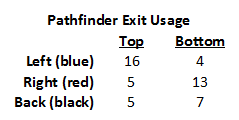Pathfinder Case Study, Door Selection
Recent Pathfinder development has been, to a large extent, focused on our new Locally Quickest approach to controlling how an occupant moves out of its current room. One of the toughest challenges during this sort of simulator development is identifying what the simulator should do. When we find published research that can be compared to our answers, its exciting and very helpful.
This morning, I noticed a post at Ped-Net which linked a Research Notes paper from VTT. That paper contained a collection of evacuation situations. One of those situations was called "Door selection test" and looked at how a group of students chose between two doors as they entered a lecture hall. This was such a perfect test for Pathfinder's new algorithms we had to check out how we compared.
The model was essentially a hallway with two doors along the side leading into the lecture hall. The researchers artificially reduced the width of the lecture hall entrance doors - presumably to make queue sizes "interesting" for a relatively small number of people. The result we wanted to check was an observation that the starting position of an occupant influenced door selection.
Here is an excerpt from the paper:
As a general observation, people on the right (relative to the direction of movement) on the starting grid chose door 2. People on the left of the grid or in the centre of the front rows chose the first door: door 1. In the back row, there was a tendency to use door 2. Other positions did not lead to a particular preference of door. This is partly explained by the narrow passage in which people in front of the group and on the left side of the group obstructed door 1 on arrival. It was natural for the right side to move towards door 2. The crowd was not large enough to block the right side of the passage permanently.
- VTT Research Notes 2562, Rinne, Tillander, and Grönberg
To test Pathfinder, we created the corresponding Pathfinder model and checked which doors our simulated occupants chose. To keep track of the starting positions, we assigned colors to the occupants roughly in the left (blue), right (red), and back (black) rows. Pathfinder simulation results are shown below.
The video above shows the Pathfinder simulation results in two different views side-by-side. At the left is a view of the actual simulation model with colored cylinders as the occupants. At the right human models are used to show occupants on a diagram of the problem. While the diagram contains dimension lines, please note that it is not drawn to scale so there are some discrepancies between the image and the actual simulation model.
Based on the observations in the paper, we should see the following patterns:
- Occupants on the left (blue) should use the top door more than the bottom door.
- Occupants on the right (red) should use the bottom door more than the top door.
- Occupants in the back (black) should use the bottom door more than the top door.
By counting colors as occupants go through each door we found the following door usage:

The table shows that we got the same usage relationships as those observed in the study. It was very gratifying to find some reinforcement that we are headed in the right direction.